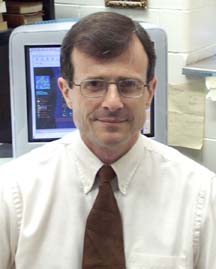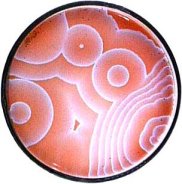Waves come and go, but a study of chemical waves by US physicists could improve our understanding of how pathogens flow around the body and how mutant genes spread through invading populations of viruses. The research might ultimately help medicine find a way to control the rate of viral mutation and so block the spread of retroviruses, such as HIV, which rely on mutations to overcome the body’s immune defences.
Boyd Edwards of West Virginia University has analysed the motion of chemical wavefronts through a filled tube with a fluid moving in the opposite direction through the tube. Intriguingly, he discovered that the chemical wavefront is not slowed by the liquid, which one would imagine contravenes at least one of the laws of nature. We’ve learned chemical waves are like pedestrians in a hurry, explains Edwards. Head winds don’t slow them down but may bend them out of shape. Tail winds, on the other hand, speed them along.

Edwards analysis – going against the flow
Edwards has previously published research on the critical wavelength needed for a river to meander and the dynamics of falling raindrops, but this current research focuses on a more esoteric phenomenon: chemical waves.
Chemical waves thrive on the diffusion and mixing of interacting ingredients. One of the most beautiful examples is the Belousov-Zhabotinsky (BZ) (BZ Ref 1 and BZ Ref 2) reaction in which a wave of changing colour sweeps through the reaction mixture. The reaction involves the interchange of a chemical by a reduction-oxidation (redox) reaction. Each step generates a catalyst that speeds up the counter reaction. Therefore, as the reduction proceeds, for instance, it produces more and more catalyst to speed up the oxidation and vice versa. The reduced state reaction is red while the oxidised state is a pale brown.

BZ reaction
It takes just a tiny fluctuation in the ingredients favourable to either the reduction or the oxidation to trigger a chain of reactive events that spread outwards from the centre like ripples on a pool. The BZ reaction left unstirred produces striking geometric growth patterns. Such patterns are reminiscent of animal patterns, such as those of water snails, leopards and zebras and indeed chemical waves were first implicated in how the leopard got its spots by Cambridge mathematician and cryptography expert Alan Turing (Turing homepage and Turing reference). As one reagent diffuses and is used up, it meets its counterpart so the reaction product diffuses ‘behind’ it and meets with its counterpart propagating the counter-reaction.
The BZ reactions and its chemical cousins bring together the reaction between ingredients and how they diffuse through the reaction mixture. Edwards has used trusted fluid mechanics equations to look at a simpler version of the BZ reaction that also involves a moving chemical wavefront. He predicted that a chemical wave front moving through a tube filled with fluid moving in the opposite direction would develop a trailing spike at the centre of the tube. The spike consumes just enough extra fluid to compensate for the flow, thereby allowing the wave front to travel at its usual speed. In contrast, a chemical wave moving in the same direction as the flow is carried along by the flow, and travels faster than one would intuitively anticipate.
Edwards says that experiments are already under way at WVU to test his predictions, while doctoral student Robert Spangler is investigating the deeper theoretical implications.
Research in chemical waves may prove to be useful in medicine, since chemical waves are similar to biological waves found in the body, Edwards explains. One example is electrical waves that cause the heart muscle to contract. Research on chemical waves might lead to the design of pacemakers which can better respond to life-threatening fibrillation. The spread of pathogens, toxins and poisons through the bloodstream might also be investigated using the fundamentals of the study.
Edwards confesses to not being an expert in genetic mutation and that is research is at a scientifically fundamental level, but he says, there may indeed be eventual ties to these biological areas. The research may also have something to say about the molecular diffusion of a pathogen into uninfected blood in the bloodstream. Non-uniform fluid flow (advection) can increase the diffusion rate of a pathogen, as some portions of the chemical wavefront are carried forward faster than others by the nonuniform fluid flow.
Further reading
Phys. Rev. Lett. 89, 104501 (2002)
http://dx.doi.org/10.1103/PhysRevLett.89.104501
Boyd Edwards
http://physics.wvu.edu/people/boyd_edwards
Turing homepage
http://www.turing.org.uk/
Turing reference
http://www.ma.hw.ac.uk/~painter/research/pigmentation/fish.html
Suggested searches
Belousov Zhabotinsky reaction
Fluid mechanics
Redox reactions